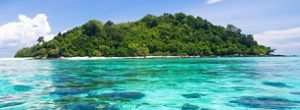The fact that this most unusual island existed at all was kept a closely guarded secret.

Unbeknownst to the rest of the world, this knowledge stayed within a relatively small group of scientists. It was their intention to carry out ongoing studies without interference from the outside world, particularly the media. They well knew that if word got out their continuing investigations would be severely hampered or even brought to a halt. It was obvious that the unique nature of the island would create intense international interest. As it was, any vessels that passed through that part of the great ocean would see only a heavily forested island, some two kilometres long and one wide. In other words, one among thousands.
It was a keen botanist who had started it all. Despite it being an extremely hot day, he was willing to hack his way through the thick forest to find out more about the peculiar looking fruit, which were in fact not fruit at all, large clusters of which were growing on every tree. He was so amazed with his findings, these being the result of simply going in for a quick prod around, that he was careful to only share his discovery with a group of like-minded specialists. These were experts that he felt could properly analyse the conundrums that the island presented. This specialist team grew to around twenty, and it was these that set up a small private research station some distance away on the mainland. This became their research facility, while using small motor boats, teams of researchers made daily forays out to the island to gather material.
There were two main forms of life on the island; plem trees and the gerbinks. The trees bore fruit-like pods that looked much like a cross between a plum and a lemon, hence the name, plem. When ripe, these burst open and release a small number of eggs that would fall to the ground. These small brown spheres, looking much like birds’ eggs, then lay on the forest floor incubating for a day or two before hatching. The second lifeform, being the gerbinks, were the creatures that emerged from the eggs. These remarkable animals are so named owing to them having a head and facial features similar to that of a gerbil and the body markings and tail like that of a skink, hence, gerbink. These portmanteau, or hybrid words were concocted by the scientists enabling their studies to progress. They would no doubt figure out what the proper scientific Latin names were, once they had figured out what they were dealing with.
At first, their investigations indicated that there was a definite imbalance on the island. From the beginning it was apparent that tree growth was heavy and overcrowded, and later it could be seen that the animals were finding it hard to survive in the congested environment. Over time it was shown that their numbers were dwindling. It was during a meeting, called specifically to address this problem that the news came. The team’s hydrologist, who had been out taking water samples, came back to announce that the island was no longer there. Within a few minutes, every member of the elite body of professionals were lined up along the shoreline scanning the horizon. Without doubt, the distant green image of the tiny island was no longer there.
All of this is a complete nonsense, of course. This became evident when the botanist, the original botanist, the unhappy, amateur botanist, who had only considered clambering onto the island for a quick prod around, woke up in his boat, drifting some distance from the island. After taking several large gulps of water, he slowly straightened from his slumped position. He stared, bleary-eyed, at the tiny island covered with trees, none of which bore fruit.
After spending a long time going back over these apparent events, together with several long periods of self-reflection, he realised that there were better ways of reducing the symptoms of his depressive disorder. He could hardly believe how truly powerful were the latent after effects of LSD.